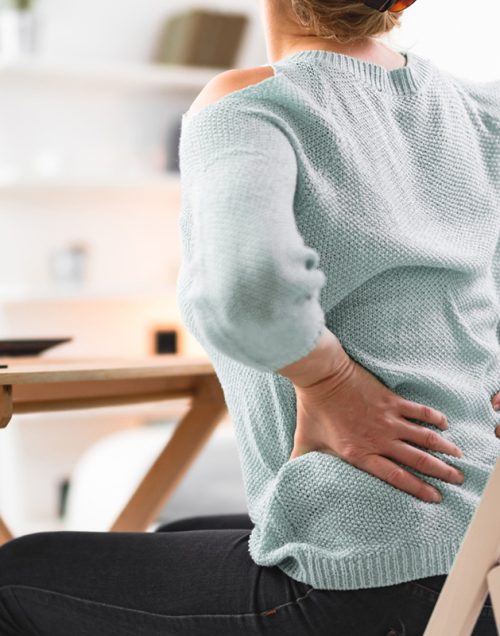Chronic pelvic pain is a condition that is still poorly understood, but for which perineal physiotherapy is your best ally!
No one is prepared to live a part of their life with physical pain and the uncertainty associated with obtaining a diagnosis. The fact that there is no explanation for the source of their pain too often defines the daily lives of people with chronic pelvic pain. Symptoms are often diffuse and echoed from another source of pain, making it difficult for professionals to identify the cause of these pains at first glance.
Chronic pelvic pain can circulate through the abdomen, pelvis, lower back and groin and buttock regions. It should not be forgotten that beyond discomfort, other sensations creep into the picture: the urge to urinate, a feeling of mass or rectal presence, genital pain, lower abdominal pain, pulling, burning, pressure, difficulty evacuating stools and urine, erection and ejaculation disorders in men, and the list goes on. You understand that this syndrome affects both men and women, but with different proportions, ranging from 4% to 15% of women and 4% to 8% of men between the ages of 35 and 50.
Several terms have been used to try to name the problem:
- Levator spasm
- Vaginismus
- Vulvodynia
- Clitorodynia
- Chronic prostatitis
- Type 3 prostatitis
- Myalgic tension of the pelvic floor
- Spasticity of the pelvic floor
- Anismus
- Painful bladder syndrome
- Interstitial cystitis
- Painful prostate syndrome
- Proctalgia fugax
As there is no specific infection or pathology, this explains why all tests are normal. Having pain to the point of having to stop working, being unable to function normally and being confronted with normal test results can become very anxiety-provoking.
Fortunately, this condition is better understood nowadays, and perineal physiotherapy is one of your best allies when it comes to your rehabilitation.

Chronic Pelvic Pain: A Syndrome
In recent years, certain findings have helped to better understand this condition. It has become clear that the identification of a single problem explaining the cascade of symptoms is utopian. Chronic pelvic pain is more in the category of syndromes, meaning that a set of symptoms characterize the problem and that they vary both from person to person and over time. The diagnosis is made when the causes likely to explain individual pelvic pain have been eliminated and when the pain persists for more than 6 months. Furthermore, research has shown that certain anxious, high-performing or perfectionist personalities may be more at risk of developing chronic pelvic pain…
The entire mechanism of pain is disrupted
The mechanism that explains the persistence of pain involves the phenomenon of local pain (inflammatory reaction at the site of pain) and central pain (the nervous system becomes excited and it becomes more difficult for the brain to reduce this discomfort). We are not saying that the pain is in your head, because in fact it is a real condition, but one that also involves pain management. As the body reacts to pain, there will be a great advantage in addressing this syndrome by working directly on the painful anatomical structures to break the vicious circle that leads to the persistence of symptoms. A person with chronic pelvic pain will need help, as stretching at home alone is insufficient. However, they will hold the reins of their own rehabilitation. Several exercises and tips will make a big difference as long as they are applied daily. And everything will have to start with good management of effort, energy, and breathing!
Our perineal rehabilitation physiotherapists will be able to help and support you through this difficult but worthwhile journey. We will be by your side day after day.
Interdisciplinary interventions targeting chronic pelvic pain
Different professionals are involved in the management of these disorders: physiotherapists, osteopaths, acupuncturists, nurses and massage therapists. They can help you find relief from persistent aches and pains by:
- Identifying daily pain management techniques with your physiotherapist
- Integrating acupuncture to help manage trigger points related to your chronic pain
- Providing access to medical prescriptions by the clinical nurse
- Finding rest and relief through massage therapy (during the appropriate phases of your rehabilitation)
Massage therapy
Massage therapy is an effective way to relieve certain muscle discomforts and stiffness. It soothes back pain, improves posture, promotes good sleep, reduces the effects of stress and anxiety, improves blood circulation, etc. Whether you’re looking for a moment of relaxation, or an orthopedic massage, different types of massage are available at the clinic to suit your needs.
Osteopathy et acupuncture
Using fine and precise palpation, the global approach in osteopathy makes it possible to relieve body discomfort in a clientele of all ages. Whether preventive or aimed at alleviating symptoms, this treatment is said to be specific, individualized and finalizes the therapeutic concept of osteopathy.
Acupuncture involves the stimulation of specific points on the skin, mucous membranes or subcutaneous tissues of the human body, using needles to improve health or to relieve pain.
Testimonials
I came to see Rachel Dumont for a significant pain in my lower back that had been bothering me for a long time. The pain was so severe that it even prevented me from sleeping. My physiotherapist greatly helped me relieve my pain and allowed me to regain better sleep and to resume my activities. It was a difficult journey, but I am glad that I did not give up and that I trusted the professionals at Cigonia.